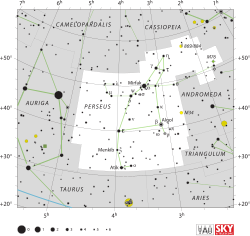HD 21278
HD 21278 är en dubbelstjärna[13] belägen i den mellersta delen av stjärnbilden Perseus. Den har en kombinerad skenbar magnitud av ca 4,99[2] och är svagt synlig för blotta ögat där ljusföroreningar ej förekommer. Baserat på parallax enligt Gaia Data Release 2 på ca 5,6[1] mas, beräknas den befinna sig på ett avstånd på ca 580 ljusår (ca 178 parsek) från solen. Den är belägen inom Alfa Persei-hopen och rör sig bort från solen med en heliocentrisk radialhastighet på ca 1 km/s.[5]
| HD 21278 | |
 | |
| Observationsdata Epok: J2000.0 | |
|---|---|
| Stjärnbild | Perseus |
| Rektascension | 03t 28m 03,07229 s[1] |
| Deklination | +49° 03′ 46,3315 ″[1] |
| Skenbar magnitud () | +4,99 (V)[2] |
| Stjärntyp | |
| Spektraltyp | B5 V[3] |
| U–B | -0,56[4] |
| B–V | -0,10[4] |
| Astrometri | |
| Radialhastighet () | +1,20[5] km/s |
| Egenrörelse (µ) | RA: +21,784[1] mas/år Dek.: -26,036[1] mas/år |
| Parallax () | 5,8334 ± 0,2298[1] |
| Avstånd | 580 ± 20 lå (178 ± 7 pc) |
| Absolut magnitud () | -1,49[6] |
| Detaljer | |
| Massa | 4,597[7] M☉ |
| Radie | 3,9[8] R☉ |
| Luminositet | 940[6] L☉ |
| Temperatur | 15 274 ± 244[9] K |
| Metallicitet | +0,00 (Fe/H) [10] dex |
| Vinkelhastighet | 75[9] km/s |
| Ålder | 187[10] eller 60[6] miljoner år |
| Andra beteckningar | |
| AG+48 399, AKARI-IRC-V1, J0328031+490345, BD+48 920, GSC 03320-02815, HIC 16147, HIP 16147, HR 1034, IRAS 03244+4853, 2MASS J03280309+4903466, PPM 46206, SAO 38849, TD1 2183, TYC 3320-2815-1, uvby98 520200774, Gaia DR2 441416161501150848 [11][12] | |
Egenskaper
redigeraPrimärstjärnan HD 21278 A är en blå till vit stjärna i huvudserien av spektralklass B5 V.[3] Den har en massa som är ca 4,6[7] solmassor, en radie som är ca 4[8] solradier och har ca 940 gånger solens utstrålning av energi[6] från dess fotosfär vid en effektiv temperatur av ca 15 300 K.[9]
Karaktären av dubbelstjärna hos HD 21278 tillkännagavs 1925 av Otto Struve.[14] Den är en dubbelsidig spektroskopisk dubbelstjärna med en omloppsperiod av 21,7 dygn och en excentricitet av 0,12.[9]
Referenser
redigera- Den här artikeln är helt eller delvis baserad på material från engelskspråkiga Wikipedia, HD 21278, 19 april 2021.
Noter
redigera- ^ [a b c d e f] Brown, A. G. A.; et al. (Gaia collaboration) (August 2018). "Gaia Data Release 2: Summary of the contents and survey properties". Astronomy & Astrophysics. 616. A1. arXiv:1804.09365. Bibcode:2018A&A...616A...1G. doi:10.1051/0004-6361/201833051. Gaia DR2 record for this source at VizieR.
- ^ [a b] Anderson, E.; Francis, Ch. (2012). "XHIP: An extended hipparcos compilation". Astronomy Letters. 38 (5): 331. arXiv:1108.4971. Bibcode:2012AstL...38..331A. doi:10.1134/S1063773712050015. S2CID 119257644. Vizier catalog entry
- ^ [a b] Zuckerman, B.; et al. (June 2012). "Stellar Membership and Dusty Debris Disks in the α Persei Cluster". The Astrophysical Journal. 752 (1): 12. arXiv:1204.3950. Bibcode:2012ApJ...752...58Z. doi:10.1088/0004-637X/752/1/58. S2CID 119207634. 58.
- ^ [a b] Mallama, A. (2014). "Sloan Magnitudes for the Brightest Stars". The Journal of the American Association of Variable Star Observers. 42 (2): 443. Bibcode:2014JAVSO..42..443M.Vizier catalog entry
- ^ [a b] Pourbaix, D.; et al. (2004). "SB9: The ninth catalogue of spectroscopic binary orbits". Astronomy and Astrophysics. 424 (2): 727–732. arXiv:astro-ph/0406573. Bibcode:2004A&A...424..727P. doi:10.1051/0004-6361:20041213. S2CID 119387088.
- ^ [a b c d] Silaj, J.; Landstreet, J. D. (2014). "Accurate age determinations of several nearby open clusters containing magnetic Ap stars". Astronomy & Astrophysics. 566: A132. arXiv:1407.4531. Bibcode:2014A&A...566A.132S. doi:10.1051/0004-6361/201321468. S2CID 53370832.
- ^ [a b] Sheikhi, Najmeh; et al. (March 2016). "The binary fraction and mass segregation in Alpha Persei open cluster". Monthly Notices of the Royal Astronomical Society. 457 (1): 1028–1036. arXiv:1601.02186. Bibcode:2016MNRAS.457.1028S. doi:10.1093/mnras/stw059.
- ^ [a b] Pasinetti Fracassini, L. E.; et al. (2001). "Catalogue of Apparent Diameters and Absolute Radii of Stars (CADARS)". Astronomy & Astrophysics (Third ed.). 367 (2): 521–24. arXiv:astro-ph/0012289. Bibcode:2001A&A...367..521P. doi:10.1051/0004-6361:20000451. S2CID 425754.
- ^ [a b c d] David, Trevor J.; Hillenbrand, Lynne A. (2015). "The Ages of Early-Type Stars: Strömgren Photometric Methods Calibrated, Validated, Tested, and Applied to Hosts and Prospective Hosts of Directly Imaged Exoplanets". The Astrophysical Journal. 804 (2): 146. arXiv:1501.03154. Bibcode:2015ApJ...804..146D. doi:10.1088/0004-637X/804/2/146. S2CID 33401607.
- ^ [a b] Gontcharov, G. A. (2012). "Dependence of kinematics on the age of stars in the solar neighborhood". Astronomy Letters. 38 (12): 771–782. arXiv:1606.08814. Bibcode:2012AstL...38..771G. doi:10.1134/S1063773712120031. S2CID 118345778.
- ^ HD 21278 (u-strasbg.fr) |Hämtad 2021-09-09.
- ^ "HD 21278". SIMBAD. Centre de données astronomiques de Strasbourg. Hämtad 2019-12-16.
- ^ Morrell, Nidia; Abt, Helmut A. (July 10, 1992). "Spectroscopic binaries in the Alpha Persei cluster". Astrophysical Journal, Part 1. 393 (2): 666–673. Bibcode:1992ApJ...393..666M. doi:10.1086/171534.
- ^ Struve, O. (December 1925). "Twelve new spectroscopic binaries". Astrophysical Journal. 62: 434. Bibcode:1925ApJ....62..434S. doi:10.1086/142944.



